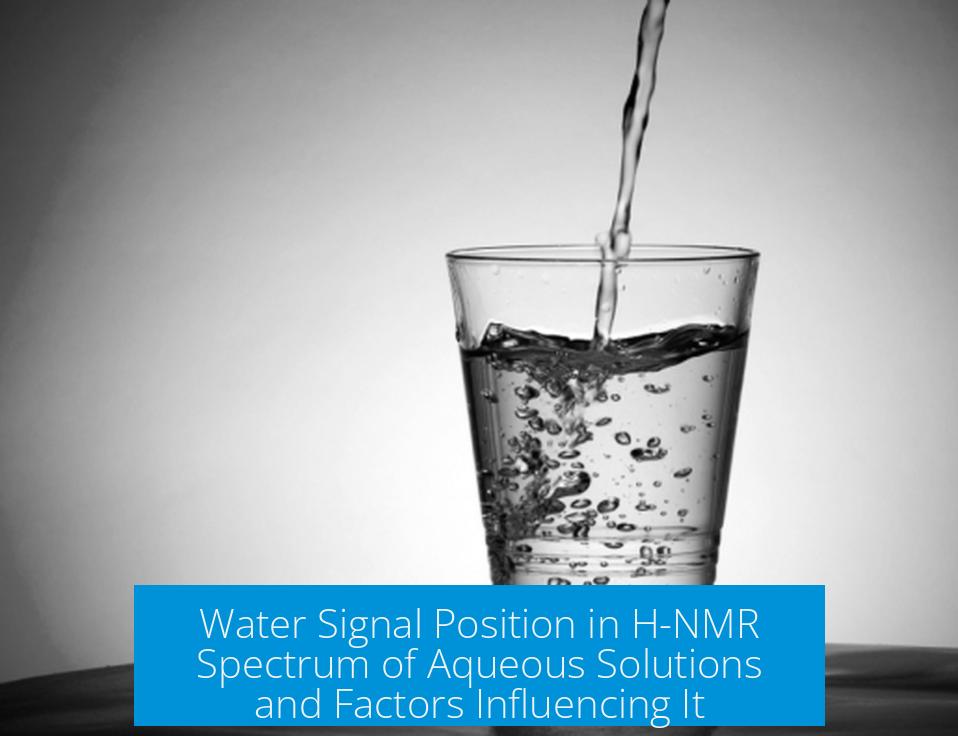Where Does Water Appear in a H-NMR Spectrum of an Aqueous Solution?
In proton NMR spectroscopy of aqueous solutions, the water signal typically appears near 4.8 ppm when using deuterium oxide (D2O) as the solvent. This peak is identifiable but varies depending on conditions such as pH and solvent composition.
Chemical Shift of Water in D2O
Water resonates at approximately 4.8 ppm in a ^1H NMR spectrum acquired with D2O as solvent. This is a common reference point for identifying the water peak. The D2O is used mainly for field locking in NMR and is often mixed with H2O to form the solvent environment.
Effects of pH and Environment
The chemical shift of water is sensitive to pH changes. As pH varies, protonation states and exchange rates influence the water peak’s exact position. The water resonance may shift slightly, but generally it remains near 4.8 ppm in D2O-based solutions.
Confirming the Water Signal by D2O Exchange
To verify if a specific peak corresponds to water, one can add a few drops of D2O to the sample. Due to rapid proton-deuterium exchange, the water proton signal will diminish or disappear from the ^1H NMR spectrum. This method confirms the identity of the water peak reliably.
Water Peak Suppression Techniques
- Water signals can dominate aqueous NMR spectra, obscuring signals from solutes.
- Solvent suppression techniques, such as the gradient pulse program zgesp, selectively reduce the water peak intensity.
- Using ~90% H2O with 10% D2O solvent mixtures allows sufficient locking while limiting water peak interference.
- Appropriate suppression improves detection of dilute components without excessive sample dilution.
Summary Table of Key Parameters
| Parameter | Detail |
|---|---|
| Typical Water Peak Position | ~4.8 ppm (in D2O solvent) |
| Effect of pH | Causes small shift in chemical shift |
| Solvent Composition | Commonly 90% H2O / 10% D2O for locking and reducing interference |
| Peak Suppression Methods | Gradient pulses (e.g., zgesp), solvent suppression techniques |
Further Reading
- NMR Chemical Shifts of Trace Impurities: Common Laboratory Solvents
- Notes on Solvents at UCLA
- Reich’s NMR Data Handouts
Key Takeaways
- Water’s proton signal appears near 4.8 ppm in ^1H NMR when D2O solvent is used.
- The exact position depends slightly on pH and solvent environment.
- D2O addition confirms the water peak by causing proton exchange and peak disappearance.
- Advanced suppression techniques improve spectra quality by reducing the water signal.
Where does the water peak typically appear in an H-NMR spectrum using D2O as solvent?
The water peak usually appears around 4.8 ppm in the proton NMR spectrum when D2O is the solvent. This chemical shift can change slightly depending on conditions.
How does pH affect the water peak in an H-NMR spectrum?
The chemical shift of water is pH dependent. Changes in pH can cause the water peak to move upfield or downfield from its usual position near 4.8 ppm.
What method confirms that a peak is from water in an H-NMR spectrum?
Adding a few drops of D2O causes the water peak to disappear due to deuterium exchange. This confirms the peak originates from water protons.
How can the water peak be suppressed during NMR measurements in aqueous solutions?
Techniques like solvent suppression using pulse programs such as zgesp reduce the water peak. This allows spectra to be recorded with ~90% H2O and 10% D2O without interference.
Why is D2O used in aqueous H-NMR solvents?
D2O helps lock the NMR instrument frequency and can exchange with water protons. Usually, only a small amount is added to minimize dilution and interference from the water peak.





Leave a Comment